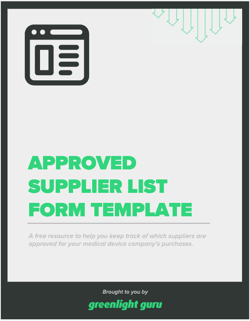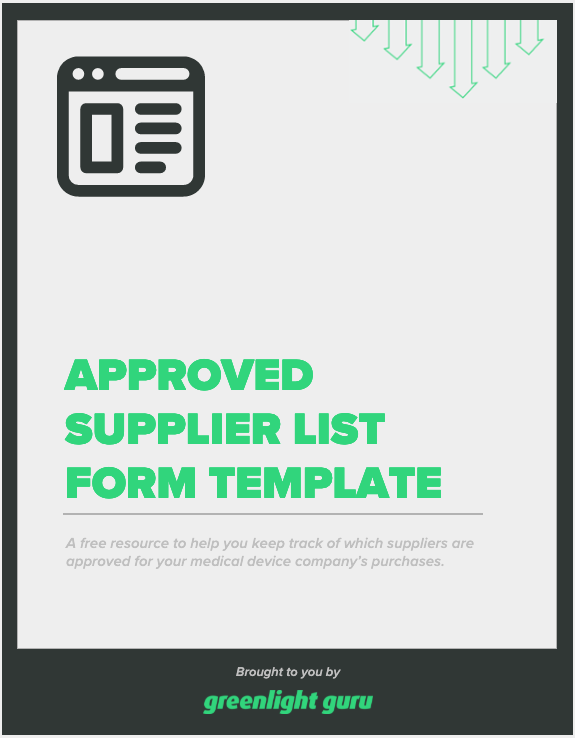3 Tips for Adding Flexibility to Your MedTech Manufacturing Supply Chain

Supply chain management is crucial to any MedTech company’s ability to deliver safe, effective, and high-quality devices to their customers.
But as anyone in the industry can tell you, ensuring that you consistently get the products and services you need to manufacture your devices is harder than it may sound. In fact, the 2023 MedTech Industry Benchmark Report found that supply chain logistics was the #1 concern post-market companies had when it came to scaling their manufacturing.
So, I want to walk you through some of the challenges that you may face in your medical device manufacturing supply chain, and how to give yourself a little more flexibility when something out of your control does happen.
BONUS RESOURCE: Click here to download a free Approved Supplier List form template.
Key challenges in the medical device manufacturing supply chain
Let’s start with the most basic requirement: getting all your parts, components, and materials on time, every time. There are a number of issues MedTech companies can run into when it comes to their suppliers and supply chains, but there are a handful that are more common than others.
Low-volume orders
If you’re making a product without a high order volume—perhaps a durable product that can be used over and over in an operating room—you might not have the kinds of large orders that suppliers like to deal with. This can become even more of a problem if the market for this particular part or component is consolidated, and you don’t have many other options.
Shortages of key parts or components
As we learned during the COVID-19 pandemic, no industry is immune to supply chain snarls that lead to shortages. But it doesn’t take a global pandemic to lead to low availability of parts or components that are necessary for the manufacture of your devices. Everything from labor shortages to geopolitics can cause disruptions in the supply chain.
Poor quality and/or late deliveries
I’m putting these together because both can be a symptom of a poor supplier, and may indicate that you need to put in more work managing a supplier—or begin looking for a new one entirely. If your orders and failing incoming inspection and you feel a supplier is becoming unreliable, that can also put a significant strain on your manufacturing timeline.
What are some strategies for enhancing efficiency and flexibility in your supply chain?
To some extent, you’re always at the mercy of your suppliers when it comes to getting the parts and components you need. But you don’t want to have a fatalistic attitude about your supply chain. Instead, you want to focus on what you can control and see if there are ways to improve the way you purchase from suppliers and work with them.
1. Build flexibility into your purchasing
In terms of preparation, there are some basic actions you can take to avoid a situation where parts stop showing up and your manufacturing shuts down entirely.
First and foremost, you can order more than you need from a supplier in order to build up a reserve of the parts or materials you need for your device. If there’s a single supplier for the part you need, planning for a rainy day this way may be your best option.
Another option is to add multiple suppliers to your Approved Supplier List (ASL) and order from them on a rotating basis. That way you can keep your suppliers happy with regular orders, but still avoid putting all your eggs in one basket.
TIP: You probably won’t be able to add suppliers to your ASL and then not order from them. It’ll be tough to find a supplier who is fine with doing the work to get on your ASL just to be a backup in case you need them somewhere down the line.
You might also consider using different suppliers for slightly different parts. For example, if you need two different sizes of a certain part, using a different supplier for each size gives you some flexibility if one of them should go out of business or become unreliable.
2. Consider wants vs needs when it comes to part specifications
In my experience, when engineers are starting their careers, they often want to get the *perfect* part—or as close to it as possible. After all, why not get parts that have the highest possible tolerance or come within a thousandth of an inch of the specs?
Well, I’ll tell you why not. Because it may be much harder to get those parts—and they may not be necessary.
When I say they may not be necessary, I just mean that sometimes it’s useful to take a step back and ask what you actually need for this device to be as safe and effective as possible. It’s great to use a part that has the highest possible tolerance you can find, but what if there are only two suppliers who can get you that part, and they’re very expensive and don’t want to take on your low-volume order?
And what if the same part with a lower tolerance will work just as well and is much easier to get?
Appropriate tolerance stack-up analysis will tell you if your parts are held to an unnecessary standard.
It’s a bit counterintuitive, but sometimes the best part is the one that isn’t perfect, but still does everything you need it to. And crucially, there may be more options for suppliers who can make that part.
Build good relationships with your suppliers
An often overlooked strategy for getting your parts on time is simply… being nice.
If you’re a low-volume customer working with a machine shop that typically does high-volume orders, then the cruel reality is that you’re not going to be their priority.
But being nice goes a long way! The customer who makes it very easy to work with them (and maybe sends some donuts with every few orders) is the customer who will get their orders squeezed in. The customer who is demanding and kind of a pain…won’t.
With all the regulatory requirements around supplier management, it’s easy to forget that there’s still a team—sometimes a small one—on the other end of your order. It may not be in any case study, but being nice is an extremely underrated supply chain management strategy.
BONUS RESOURCE: Click here to download a free Approved Supplier List form template.
Simplify supplier management with a MedTech-specific QMS
One of the best ways to manage risks within your supply chain and understand the health of your supplier relationships is by using a QMS solution that gives you a complete view of all your supplier documentation and quality data in one place.
With Greenlight Guru, you get a single source of truth for all your documentation, including supplier management, and you maintain closed-loop traceability throughout the entire product lifecycle.
Greenlight Guru also helps you conduct better supplier audits, flagging certain suppliers for follow-up actions and linking to nonconformance issues to determine if you’ve had problems in the past—and may need to take action to keep your supply chain humming. It all creates a highly visible system that’s easy to navigate and understand.
If you’re ready to make supplier management a competitive advantage for your medical device company, then get your free demo of Greenlight Guru today!
Etienne Nichols is the Head of Industry Insights & Education at Greenlight Guru. As a Mechanical Engineer and Medical Device Guru, he specializes in simplifying complex ideas, teaching system integration, and connecting industry leaders. While hosting the Global Medical Device Podcast, Etienne has led over 200...
Related Posts
Carrying out a supplier audit: when and how to audit your suppliers
3 Key Steps for Supplier Risk Assessment in MedTech
4 Problems (and Solutions) for the Medical Device Supply Chain
Get your free download
Approved Supplier List Form Template











